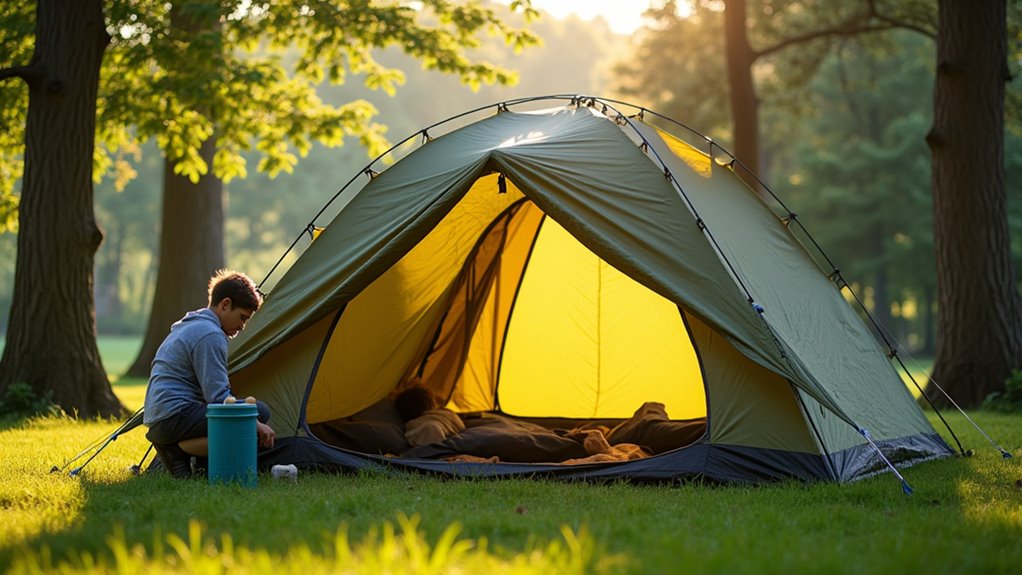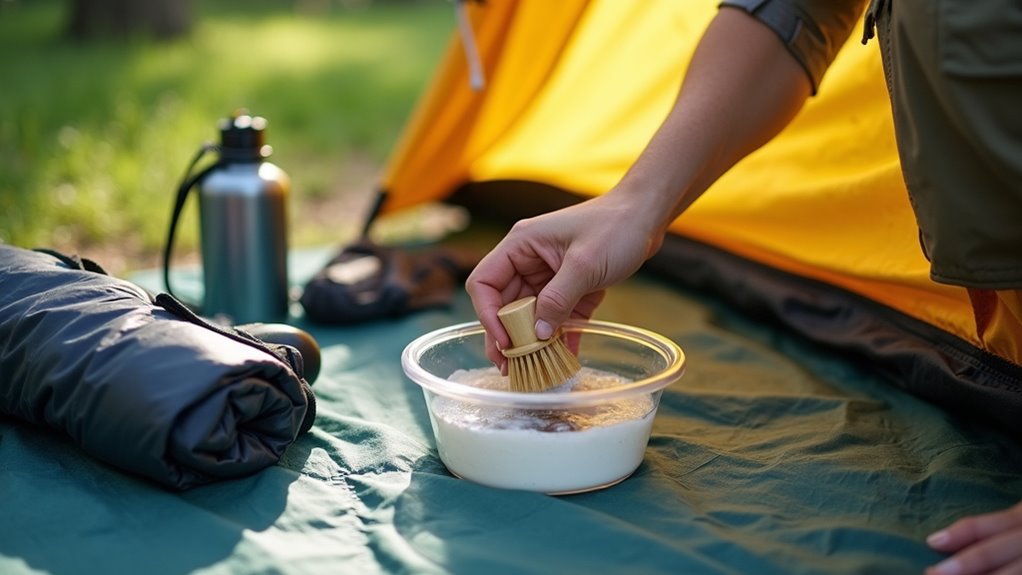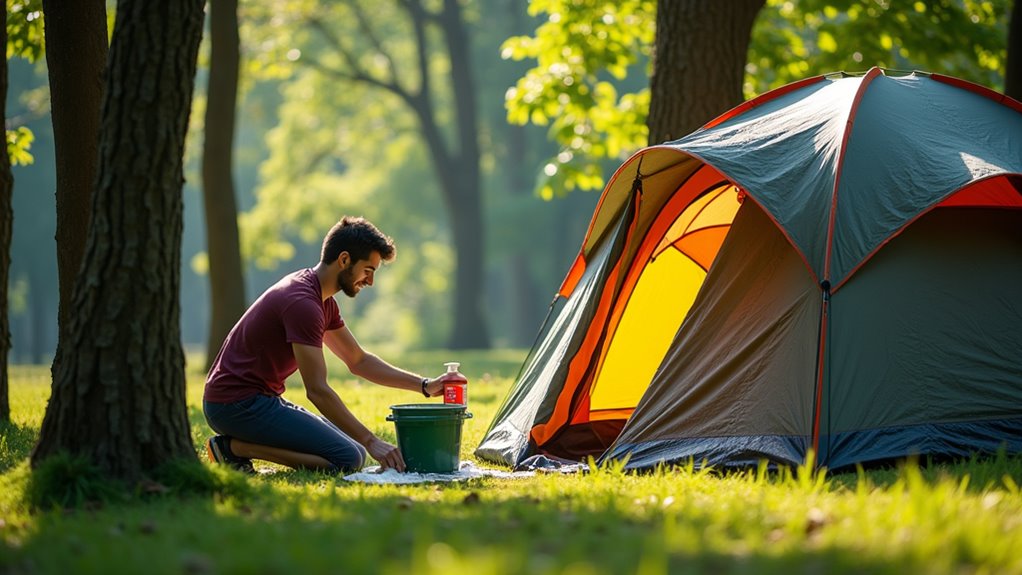How To Clean Your Tent
This post contains affiliate links. As an Amazon Associate, we earn from qualifying purchases.
To clean your tent effectively, begin by inspecting it for any damage and repairing tears before washing. Use mild soap, soft sponges, and brushes to gently remove dirt, rinsing thoroughly afterward. This overview covers the essential steps, with more detailed guidance on cleaning techniques and maintenance provided below for those interested in extending your tent’s lifespan.
Essential Facts in 30 Seconds
- Check and repair any tent damage before cleaning.
- Hand wash with mild soap and soft sponges; avoid harsh chemicals.
- Rinse thoroughly and clean zippers with a soft toothbrush.
- Dry in the shade with good airflow to prevent mold.
- Store in a breathable bag only when completely dry.
Preparing Your Tent for Cleaning

Start by checking your tent for tears or damage. Fix any problems before cleaning to avoid making them worse.
Gather soft sponges, soft brushes, and mild soap like Nikwax Solar Wash®. Open all zippers on doors and windows to let air flow inside.
Lay the tent flat on a clean surface. Turn it inside out if you plan to soak it. Take off poles and stakes to protect them from water.
Shake the tent outside to remove loose dirt. Spray gently with a garden hose to rinse dirt away. It’s important to remove all soap residue to prevent future fabric issues. Make sure to eliminate odors by drying the tent completely before storing it.
These steps keep your tent safe and clean.
Washing and Cleaning Techniques
Washing your tent needs care to keep it strong and clean. Use mild soaps without strong smells. Special sport cleaners like Atsko® Sport-Wash or Grangers® Tent + Gear Wash protect your tent’s water-repellent coating. Before washing, inspect the tent for any damage to ensure it can withstand the cleaning process.
Wash your tent by hand in a bathtub. Move it gently to avoid damage. Clean dirty spots with a soft cloth or sponge. Rinse well to remove all soap.
Clean zippers with a soft toothbrush to get rid of dirt. Hang your tent to dry in the shade with good air flow. This stops mold and makes your tent last longer. Remember to ensure thorough rinsing to avoid soap residue, which can harm the fabric.
Taking care of your tent keeps it safe and ready for camping fun.
Addressing Stains and Specific Issues

Act fast to stop stains from ruining your tent. Mold grows quickly and can damage fabric, so it’s important to ensure that the tent is completely dry before storage. Use Iosso Mold and Mildew Stain Remover® or mix vinegar and water. Scrub the mold spots gently. Wait 10 minutes, then wash off well with clean water. Resin stains get hard over time. Let resin dry, then hold ice cubes on it to make scraping easier. Use a spoon carefully to scrape without tearing fabric. Honeydew stains need quick cleaning. Use lukewarm water and a soft brush. Clean right away to save your tent fabric. Regular maintenance can help prevent future mildew growth. Check the table below for easy stain fixes:
| Stain Type | How to Clean | Tips |
|---|---|---|
| Mold/Mildew | Iosso remover or vinegar mix | Rinse well after cleaning |
| Resin/Sap | Freeze with ice, then scrape | Use soft tools to protect fabric |
| Honeydew | Lukewarm water, soft brush | Clean fast to avoid damage |
Drying and Proper Storage
Drying and storing your tent properly keeps it strong and working well. After camping, shake off water and wipe the fabric with a soft towel. Keep the tent up as long as you can. Let sun and wind dry it. Open all doors and windows to let air flow through. Place the tent in sunlight for a short time to dry faster.
At home, dry your tent fully in a place with good air. Hang it on a clothesline so air reaches all sides. Store your tent in a bag that lets air pass. Avoid plastic bags that trap moisture. It is also important to check seams, zippers, and corners for retained moisture to ensure it is completely dry. Be sure to inspect fabric for tears before packing to maintain its durability.
Keep the tent in a cool, dry, and dark spot. Stay away from damp basements. Check your tent often for mold or damage. Always make sure it’s completely dry before packing to stop mildew from growing.
Maintenance and Waterproofing Tips

Keep your tent strong and dry with regular care. Start by sealing the seams. This stops water from leaking through stitch holes. Take off old seam tape first. Clean the seams with rubbing alcohol. Then, spread new seam sealer evenly along all seams. Watch for worn spots and cover them well.
Next, refresh the tent’s Durable Water Repellent (DWR) coating. This layer makes water bead and slide off the fabric. When water no longer beads, it’s time to reapply. Spray a waterproof product like Scotchgard Outdoor Water Shield. Hold the spray 20-30 centimeters away for even coverage. Regularly check the tent’s waterproof rating to ensure it meets your needs.
Check the urethane waterproof layers too. If leaks appear, add a new coat. Follow the product’s instructions carefully. Always waterproof your tent when it’s clean and dry. This helps the treatment stick better and lasts longer. Regular maintenance ensures the longevity of the tent, allowing you to enjoy outdoor adventures without worrying about leaks.
Regular maintenance can extend your tent’s life. A well-kept tent stays dry and comfortable on every trip.
Frequently Asked Questions
Can I Use a Washing Machine to Clean My Tent?
Using a washing machine to clean a tent can cause serious damage. Machines can tear the fabric and ruin waterproof coatings. These coatings keep water out and protect the tent from rain. Washing machines also spin too fast, which can stretch or break tent poles and seams. Gentle cleaning works best. Hand wash your tent with mild soap and cold water. Use a soft brush or cloth to remove dirt. Rinse well and let it dry completely before storing. This care helps your tent last many camping trips. Simple steps protect your gear and save money in the long run.
How Often Should I Clean My Tent?
Tents do not like dirt. Clean your tent after every trip or every few months. This stops mold and mildew from growing. Dirt can damage the fabric and zippers over time. Use mild soap and water for cleaning. Let the tent dry fully before storing it. Clean tents last longer and stay strong in bad weather. Keep your gear in good shape by cleaning often.
Is It Safe to Use Bleach on My Tent?
Bleach can damage your tent fabric and coatings. It can make materials weak and cause colors to fade. Use gentle soap and water instead. This method cleans well without harm. Your tent stays strong and lasts longer. Always rinse well after washing to remove soap. Avoid harsh chemicals to keep your tent safe. Simple care helps your gear stay ready for adventure.
What Should I Do if My Tent Smells Bad?
A bad smell in your tent often means mildew or dirt. Clean your tent using warm water mixed with mild soap. Rub gently to remove odor-causing dirt. Rinse well to get rid of soap. Dry the tent completely under the sun or in a dry place. Moisture left inside causes mildew and bad smells. Store your tent in a cool, dry spot. Avoid folding it when wet. Regular cleaning and drying keep your tent fresh and odor-free. A clean tent lasts longer and feels better during trips.
Can I Use a Hairdryer to Speed up Drying?
A hairdryer can damage your tent and itself by overheating. It blows hot air too fast, which harms fabric and zippers. Air drying works best to keep your tent safe and dry. Fans help move air and speed up drying without risks. Let your tent dry in the shade for best results. This method keeps your tent strong and ready for your next trip.
Conclusion
Keeping your tent clean helps it last longer and work better. Dirt and grime can damage fabric and zippers over time. Clean your tent after every trip to avoid mold and bad smells. Use mild soap and water; avoid harsh chemicals that harm the material. Dry your tent fully before packing to prevent mildew. Store it in a cool, dry place away from direct sunlight. A clean tent stays strong and ready for your next outdoor trip. Taking care of your tent saves money and keeps your adventures safe and comfortable.
